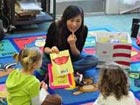| Videos | • Latest |
|
• Feature | • Sports | • Your Videos |
Chinese curriculum popular in US

 0 Comment(s)
0 Comment(s) Print
Print E-mail CNTV, February 21, 2012
E-mail CNTV, February 21, 2012
According to a U.S. survey, three percent of American elementary schools teach Chinese language. Many of them, using materials created and sold by a Korean-American woman who realized nearly 20 years ago, that Chinese would be one of the global languages of the future.
For Selina Yoon, story-time at this private school in New York City is market research.
Selina Yoon, CEO of Master Communications, said, " I love watching their smiling face and how engaged they are and how that's helping them learn."
But 17 years ago, when her own children were this age, there were no schools like this. Selina still wanted them to learn Chinese.
Selina Yoon said, "When you look at the population growth and potential, I was convinced that that was the language of the future. I really felt that for their future that it was important for them to be bilingual and know Chinese."
Selina left her job as a marketing executive for Procter and Gamble, and used 100, 000 dollars she had saved to develop "Asia for Kids". She assembled a catalogue of educational toys, books, and created her own distribution system and then took a big risk in this ad.
Correspondent: "So you spent almost 10 thousand dollars on an ad in a national parenting magazine. Was it worth it?"
Selina: "Absolutely. It was the best learning I got. And I was getting instead of 100's of phone calls, thousands of phone calls."
Half of the calls, Selina says, came from educators. People like Sharon Huang, she started Bilingual Buds eight years ago to teach Chinese to toddlers.
Sharon Huang said, "Hardly anything was available, so what we would have to do is buy story books in English and I would pay teachers to translate. Learning language, you really need to hear stories because that's where grammar and vocabulary are in context."
Now, Sharon Huang buys books, blocks and many of these songs from Selina's company, Mater Communications.
Demand for Chinese education materials in the United States is only growing. According to a national survey by the center for applied linguistics, between 1997 and 2008, the percentage of elementary schools offering Chinese increased tenfold.
3% of American elementary schools now offer Mandarin, and Selina has capitalized on American interest in China.
Selina: "We hit our first million dollars probably within the first two or three years."
Correspondent: "Pretty fast."
Selina: "Pretty fast."
Her company now works with more than 100, 000 schools around the world and she now creates nearly half the products she sells, designing animation, music and videos to teach Chinese and more than 100 other languages.
Sharon Huang said, "There are a couple of companies that do what she does, but she's been doing it for so long that I can say that she's in a category of 2 or 3."
So what's next a global business series – teaching business culture and language to adults? So when these children grow up, they can learn the skills they need to work in China. Selina said, "We're kind of growing up with our own customers."






Go to Forum >>0 Comment(s)